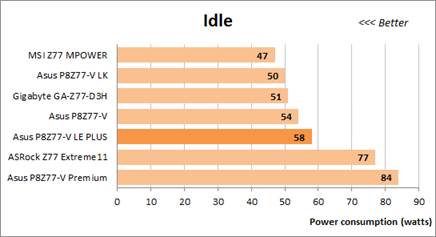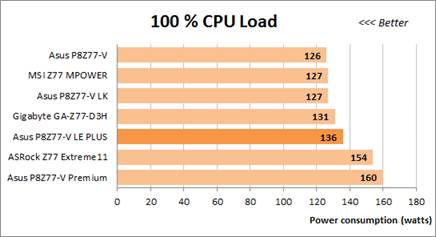Power-consuming process
We perform our power-consuming measures by
using Extech Power Analyzer 380803. This device is connected before PSU and
measure the power level of the entire system (no screen), including the power
loss happening even in PSU. At idle mode we start up the system and wait until
it stop accessing the hard drive. Power consumption in case of single-threaded CPU
is measured while running Pi-digits efficiency test, and in case of
multi-threaded load – while running Fritz Chess Benchmark test. We have also
used the Hitman Absolution game to create complex load. The results on the
diagram are all arranged in ascending order and the result of Asus P8Z77-V LK is
marked with darker color for your convenience.

Idle
mode

1
CPU Thread

100%
CPU Load

CPU
+ GFX
Unlike other basic motherboards from ASUS,
P8Z77-V LE PLUS doesn’t save energy. Though the power-saving tech related to the
CPU of Intel is activated on it by default, it still needs plenty of power.
Though it need much less power than the premium model of ASRock and ASUS, it
power need is not a typical of the regular product because it has an additional
PCI Express button.
You can try to make it save more, even at
high load and idle mode, by allowing EPU Power Saving mode in BIOS or with
switching to airport mode.
Now, let’s compare how much energy this
system need when overclocking.

Idle
mode

1
CPU Thread

100% CPU Load

CPU
+ GFX
P8Z77-V LE PLUS is compared about power
consumption to other usual motherboard at default settings, but it’s the most
saving one among those at overclocking settings (with the exception of 2
special models). That’s an embarrassment for a basic product which is expected
to need little power.
Conclusion
Like most of other motherboard from ASUS,
P8Z77-V LE PLUS leaves a good impression in general look, but it somewhat
spoils due to having no ability to overclock CPU to its max, because of high
power consumption (especially in overclocking). This is not a very serious
disadvantage as the extra100 MHz of CPU clock rate can’t ensure the operating
efficiency benefit and power consumption is not actually terrible, but we’re
very disappointed.
P8Z77-V LE PLUS stands at the middle place
of the product of ASUS. It has mode functions than the basic products, has more
advanced electric system and USB Flashback BIOS support, but it doesn’t save
energy.
Like other ASUS motherboards, it has the
advantage as an easy-to-use and 3-year- PCB design and it lets out some of its
own benefits. You need to notice that while it’s for sale at a remarkably
cheaper price, this product model offers the same features as P8Z77-V. It only
lacks wireless techs, but instead of having an eSATA 6 gigabit / second port
you can’t find on P8Z77-V. Being the most advanced basic model, it lags behind P8Z77-V,
the least convenient model in the towering models of ASUS motherboard. However,
if you don’t expect too much from P8Z77-V LE PLUS, it won’t let you down.
Technical
specs
|
Processor socket
·
LGA 1155
Chipset
·
Intel Z77 Express
Memory
·
4x1.5 V DDR3 DIMM, 32 GB max capacity, dual-channel
structure, DDR3 3200-800 SDRAM
Expanded slots
·
2 x PCI Express 3.0/2.0x16 (1x16 or 2x8)
·
2 x PCI Express 2.0 x 1
·
1 x PCI Express 2.0x16 (x4)
·
2 x PCI
Multi-GPU configuration
·
Nvidia Quad-GPU SLI tech,
·
AMD Quad-GPU CrossFire X
·
AMD 3 –Way CrossFire X
·
LucidLogix Virtu MVP
Sound
·
8-channel Realtek ALC892 HD audio codec
Network connection
·
Realtek RTL8111F Gigabit network connection
controlling device
Extra controlling device
·
Marvell 88SE91xx (6 Gbs)
USB 3.0
·
Intel Z77 Express
·
ASMedia ASM1042
Fan
·
4 4-pin fans in total
Form-factor
·
ATX, 305x244 mm
Other features
·
USB Flashback tech
·
MemOK! And USB BIOS Flashback bottom
·
TPU and EPU
·
Q-DIMM and Q-slot port
·
Q-LED cho CPU, DRAM, LED Boot Device
Internal ports
·
USB 2.0: 4 (8 additional)
·
USB 3.0: 1 (2 additional)
·
SATA 6.0: 3
·
SATA 3.0: 4
External ports
·
PS/2: 1 (for keyboard or mouse)
·
USB 2.0: 2
·
USB 3.0: 4
·
LAN: 1
·
e-Sata: 1
·
Analogue audio: 6
·
Digital audio: Optical SPDIF out
·
Video:
D-Sub, DVI-D, HDMI, DisplayPort
|